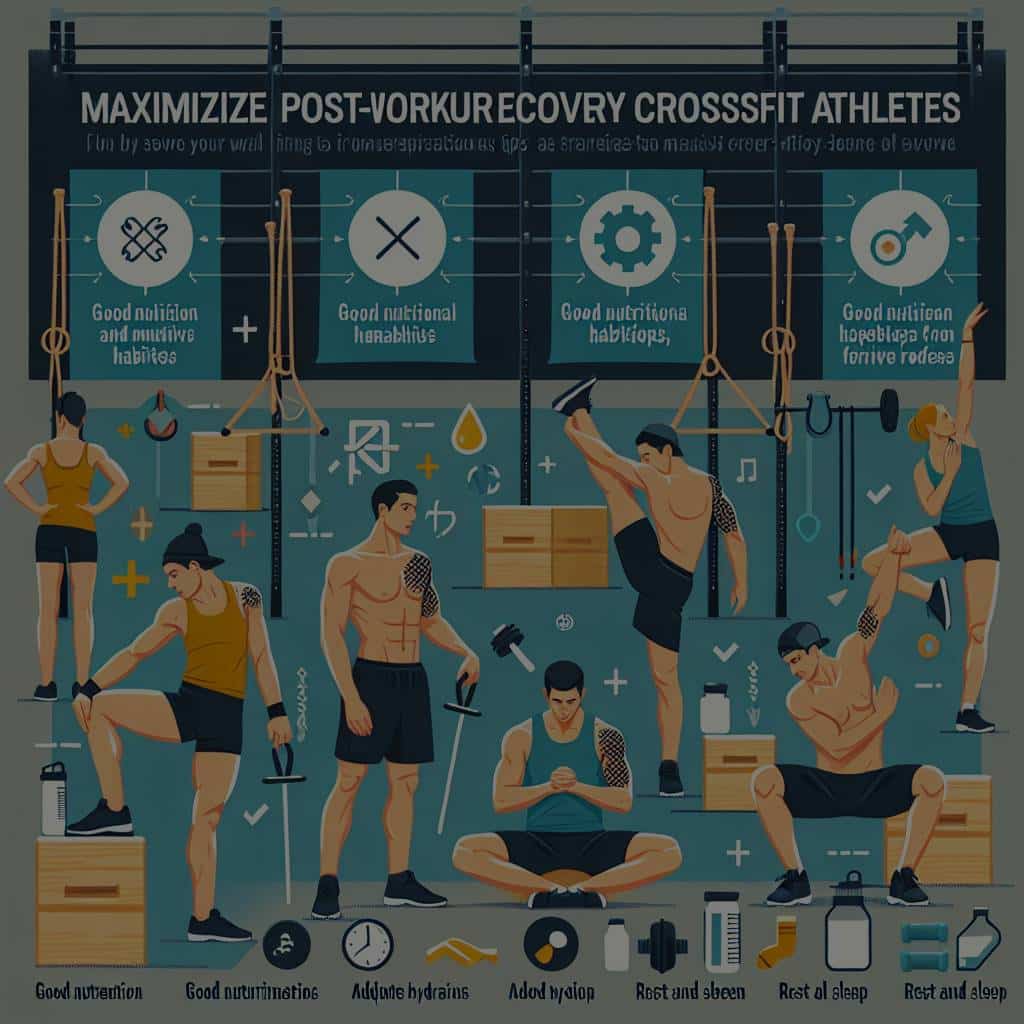How to Maximize Post-Workout Recovery for CrossFit Athletes?

CrossFit is a high-intensity fitness training method renowned for its ability to build strength, agility, and endurance. Yet, the long-term success of a CrossFit athlete hinges not merely on their workouts but, crucially, on their post-workout recovery. You must understand that your muscles grow not during training but during sleep and post-workout rest periods, where the body repairs and rebuilds the muscle fibers broken down during workouts. Effective recovery can help enhance performance, prevent injuries, and promote muscle growth.
In this article, we will focus on the key factors that contribute to an efficient recovery: nutrition, sleep, and the timing of your workouts. We will explore how they can help you recover, adapt to the high demands of CrossFit training, and reach your fitness goals.
A lire en complément : How Can Youth Athletes Learn to Mentally Prepare for National Competitions?
Eating Right for Recovery
Nutrition plays an indispensable role in post-workout recovery. What you consume after your training can profoundly impact how quickly your body recovers, repairs the wear and tear of muscles, and prepares for the next workout.
Protein is a crucial nutrient that aids muscle repair and growth. Following a CrossFit workout, your muscles are primed to accept nutrients that can stimulate muscle repair, growth, and strength. Consuming a high-protein meal or shake can help replenish protein stores in your muscles and boost recovery.
Sujet a lire : What Are the Benefits of Mixed Martial Arts Training for Self-Defense?
Carbohydrates are equally important. They replenish glycogen stores—your muscles’ primary source of energy during high-intensity workouts. A post-workout meal rich in high-quality, complex carbohydrates can help restore glycogen levels, reducing muscle soreness and fatigue.
Hydration is another vital aspect of recovery nutrition. Water supports every metabolic process in your body, including nutrient transport and muscle repair. Ensure you replace the fluids and electrolytes lost during your workout to prevent dehydration, which can slow down your recovery process.
Prioritizing Sleep for Muscle Recovery
Sleep is when most of your body’s recovery and repair processes occur. It’s a natural, restorative state that allows your body to heal, repair, and rejuvenate. Lack of sufficient sleep can impair muscle recovery, decrease performance, and increase the risk of injuries.
During sleep, your body releases human growth hormone (HGH), which helps repair and build muscles after a workout. Inadequate sleep can disrupt the release of this hormone, affecting muscle recovery and growth.
Quality sleep also helps restore the nervous system, which plays a significant role in producing muscle contractions and coordinating movements. A well-rested body will perform better, adapt more effectively to training, and reduce the risk of overtraining and injuries.
Timing Your Workouts
The timing of your workouts can also influence your recovery and results. For instance, if you’re performing two workouts in a day, adequate rest time in between is crucial to allow your body to recover and prepare for the next session.
Active recovery, involving light activities like walking, cycling, or yoga, can help improve blood flow, reduce muscle soreness, and enhance overall recovery. It’s a good practice to dedicate time for active recovery, especially after high-intensity workouts.
Rest days are equally key to your training program. They allow your muscles to repair, rebuild, and strengthen. Be sure to include at least one or two rest days in your weekly workout schedule to give your body an opportunity to recover fully.
Post-Workout Recovery Techniques
Recovery techniques employed post-workout can help reduce muscle soreness, speed up recovery, and improve overall performance. Traditional methods include stretching, foam rolling, and massage.
Stretching after a workout can help increase flexibility, improve circulation, and decrease muscle tension. It’s a simple yet effective recovery tool that can aid in flushing out toxins from muscles and increase oxygen supply, promoting faster recovery.
Foam rolling, a self-myofascial release technique, can help reduce muscle tightness, soreness, and inflammation. It can improve your range of motion and performance in your next workout.
Massage can help stimulate blood flow, soothe muscle soreness, and speed up recovery. It can also decrease stress levels, which in turn can improve the quality of your sleep—a crucial element of recovery.
Implementing a Recovery Plan
Implementing a recovery plan is an integral part of your training program. A well-rounded recovery strategy can help you bounce back more quickly and efficiently, reducing the risk of injury and overtraining, and enhancing your overall CrossFit performance.
A recovery plan should take into account your personal needs, the intensity and frequency of your workouts, and your fitness goals. It’s important to experiment with different recovery strategies, monitor your body’s response, and adjust your plan as needed.
Remember, your recovery is just as important as your workouts. Prioritizing post-workout recovery can help you reap the benefits of your CrossFit training, maintain high performance, and achieve your fitness goals in a sustainable manner. It’s time to give recovery the attention it deserves!
Effectiveness of Protein Supplements and Hydration on Muscle Recovery
Incorporating protein supplements into your post-workout recovery plan can be especially beneficial for CrossFit athletes. The intense nature of CrossFit workouts breaks down muscle tissue, creating a need for protein to help repair and build these muscles back up.
Protein powder, such as whey or casein, can provide this necessary protein in a convenient, easy-to-digest form. Consuming a protein shake within 30 minutes of your workout can kick-start your muscle recovery process, helping to reduce muscle soreness and boost muscle growth.
Remember, however, that these supplements are not a replacement for a balanced diet. They should be used as a supplement to your diet to ensure you’re meeting your protein needs, especially after a high-intensity CrossFit workout.
Hydration is another factor that cannot be overlooked. During a strenuous CrossFit workout, your body loses significant amounts of fluid through sweat. This loss can lead to dehydration, which can hinder your performance and slow down your recovery time.
Rehydrating is essential to replacing these lost fluids and electrolytes, supporting your immune system, promoting optimal blood flow to your muscles, and aiding in nutrient transport. Sports drinks that contain electrolytes can be beneficial, but plain water is usually sufficient for most people.
Recovery Techniques: Foam Roller and Active Recovery
CrossFit athletes often experience muscle soreness due to the high-intensity nature of the workouts. One effective method to combat this soreness and enhance your workout recovery is the use of a foam roller. This self-myofascial release technique helps to loosen up tight muscles, improve blood circulation, and decrease muscle tension.
By using a foam roller post-workout, you can help to speed up your recovery time, reduce muscle soreness, and prepare your body for your next CrossFit workout.
Active recovery is another beneficial technique often utilized in the CrossFit open. Instead of complete rest, active recovery involves engaging in low-intensity activities on your rest days. These activities, such as walking, cycling, or yoga, can help to improve blood flow to your muscles, reducing muscle soreness and enhancing your overall recovery.
Conclusion: The Importance of Post-Workout Recovery for CrossFit Athletes
In conclusion, understanding the importance of post-workout recovery is crucial to the success of any CrossFit athlete. By prioritizing recovery through proper workout nutrition, implementing active recovery techniques, and utilizing aids such as protein powder and a foam roller, you can significantly enhance your muscle recovery, reduce muscle soreness, and prepare your body for the next high-intensity CrossFit workout.
You don’t need to wait until the CrossFit games to start your recovery strategy. Start incorporating these recovery techniques now to maximize your performance, prevent injuries, and ensure you’re getting the most out of your CrossFit workouts. Remember, the key to sustainable success in CrossFit doesn’t just lie in the intensity of your workouts, but also in the quality of your recovery time.
